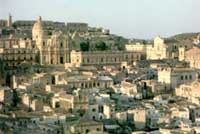Late
Baroque Towns of the Val di Noto (South-eastern Sicily)
 The
eight towns in south-eastern Sicily: Caltagirone, Militello Val
di Catania, Catania, Modica, Noto, Palazzolo, Ragusa and Scicli,
were all rebuilt after 1693 on or beside towns existing at the time
of the earthquake which took place in that year. They represent
a considerable collective undertaking, successfully carried out
at a high level of architectural and artistic achievement. Keeping
within the late Baroque style of the day, they also depict distinctive
innovations in town planning and urban building. The
eight towns in south-eastern Sicily: Caltagirone, Militello Val
di Catania, Catania, Modica, Noto, Palazzolo, Ragusa and Scicli,
were all rebuilt after 1693 on or beside towns existing at the time
of the earthquake which took place in that year. They represent
a considerable collective undertaking, successfully carried out
at a high level of architectural and artistic achievement. Keeping
within the late Baroque style of the day, they also depict distinctive
innovations in town planning and urban building.
http://whc.unesco.org/sites/1024rev.htm
 |
CALTAGIRONE
- The
visitors of Caltagirone cannot fail to notice the outward
signs of a thriving industry now synonymous with the name
of the place: brightly painted ceramics not only fill shop
windows with a profusion of vases, plates and other household
goods, they also decorate bridges, balustrades, frontages
and balconies. This bears witness to an art which, here, is
as old as the origins of the town itself ... (continue)
|
 |
CATANIA
- A
renowned port and Sicily’s second largest city, after
Palermo, with its 350,000 inhabitants, Catania is among Italian
hottest cities with a summer temperature that can exceed 40°
degrees. It was home to such great artists as the composer
Vincenzo Bellini (1801-1835) and the writer Giovanni Verga
(1840-1922). ... (continue)
|
 |
MILITELLO
IN VAL DI CATANIA - Militello
Val di Catania counts some 10,000 inhabitants and owed much
of its past prosperity to Joan of Austria (1573-1630) –
Charles V’s grand-daughter and wife to Francesco Branciforte
– a woman with a strong predilection for sophisticated
culture and taste for beautiful things. Thanks to her, Militello
became an aristocratic court entering its heyday. The streets
of the old town are lined by beautiful secular and religious
building
... (continue)
|
 |
MODICA
- “Modica.
Noble, opulent and populated city, seat of the ancient and
vast County”. This
18th century description by historian and clergyman Vito Amore
elegantly summarizes the political, economical and cultural
importance of this city whose history is rooted in remote
ages and events. Historical sources maintain that a town called
Motyca, hereabouts, was inhabited by prehistoric peoples,
called Sikels, around the 7th century BC., at the time of
the Greek Colonization of Sicily; the historian Mario Carrafa,
in the 18th century, told of Greek coins discovered the area,
bearing the inscription Motayon ... (continue)
|
 |
NOTO
- In
a region populated by olive and almond trees, Noto sits on
a plateau dominating the valley of the Asinaro and its citrus
plantations. This tiny Baroque jewel endowed with an opulent
beauty is the result of a single tragic event: the earthquake
of 1693, that, despite bringing death and destruction to this
part of Sicily, also sparked a huge effort to rebuild. Previously,
the town that stood some 9-10km away (see below Noto Antica)
had its origins way back in Antiquity ... (continue)
|
 |
PALAZZOLO
ACREIDE - At
the top of the hill, where the acropolis used to lie, all
that is visible of the small Greek theatre built of white
stone is the floor of the orchestra and this actually dates
from Roman times. To the right lay the bouleuterion, a stepped
meeting-area, connected to the theatre by a narrow passage
leading straight into the cavea. Near the gate that seals
off the excavation area on this side, may be seen a section
of the old plateia (main road running from east to west) paved
with large slabs of lava stone ... (continue)
|
 |
RAGUSA
IBLA - Ragusa
Ibla was founded on the site of ancient Sikel town Hybla Herea,
of which remains have been found, such as rectangular burial
niches in the Gonfalone valley, along the road to Modica.
Some of these have been faithfully reconstructed within the
Archaeological Museum of Ragusa. Few centuries later, Ragusa
was taken by the Greeks who would largely influence all Sicily’s
culture. A few necropolises discovered in the surrounding
territory (along Cartolillo, Cava Pece, Cucinello and Tabuna
districts) is all that remains of that period ... (continue)
|
 |
SCICLI
- Scicli
is a most lovely city in the province of Ragusa, lying on
a vast valley amidst rocky mountains, where the San Bartolomeo,
the Santa Maria La Nuova and the Fiumara di Modica rivers
join. Its 18th century look most resulted from the reconstruction
that followed the terrible earthquake of 1693. Thanks to its
elegant palazzi and churches, and its picturesque shape, it
is famously known as the “Baroque Jewel” ... (continue)
|
|
• Hotels
• Farm
Holidays
• Bed
and Breakfast
• Holiday
Houses
• Restaurants
• Postcards
• Photos
• Maps
• Weather
• The Beaches
• The Islands
• The Holy Places
• The Reserves and Parks
• The Castles
• The Archeological
Sites
• The Museums
 
buy
on line
Michelin Green
Guide of Sicily
in
italiano | in
english
|

